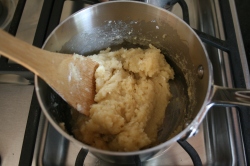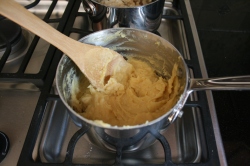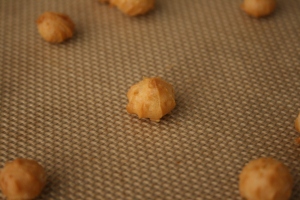The 1916 Cookbook Project: The Last Crouton
Technically Grandpa didn’t title this recipe as a “crouton” but it is yet another soup garnish. I found it interesting that he used choux pastry to make a garnish; I’ve always thought of creme puffs as a sweet, not savory, dish. I also thought of them as large items requiring a fork and knife; not tiny morsels delicately floating on a plate of soup.
Reading through the thin instructions, I realized this was a recipe where I might have real, not “sort of”, success! I grew up helping Ma make avgolemono chicken soup (greek chicken soup with lemon and egg), carefully pouring hot chicken soup broth into the raw eggs and lemon juice she frantically whisked the concoction. We did this without ever curdling the eggs. My tyropita (cheese pie) recipe involves whisking a raw egg into the hot cheese mixture. I had the experience; I had the technique. Yes, I finally found something that might be in my wheelhouse…or so I thought.
Recipe 4 Beads of Profiteroles
The translation:
“In a saucepan put a glass of broth, water, a piece of butter the thickness of half an egg. Bring this to a boil. Remove from the heat and add enough flour to make a tight paste. Next add three eggs, one after the other, mixing well. Knead the dough and make small, chickpea sized, beads. Bake them in the oven.”
Once again I was facing a recipe with no real measurements, no temperatures, and no estimated cooking time. Heck, this time he didn’t even define what type of broth. Chicken? Vegetable? Beef? I wondered – had the printer charged by the letter to publish the book?
What I Did:
Guesstimate of the ingredients:
½ cup beef broth
½ cup water
2 Tbs butter (½ oz butter = 1 Tablespoon)
1 cup flour ( 135 grams)
3 eggs (put each in a separate container to make adding them easier)
I combined the beef broth, water, and butter in a saucepan as directed and brought it to a boil. Actually, I put the broth and water in a pot, forgot the butter, added the flour, realized why I shouldn’t have forgotten the butter and started over.
Next I removed the boiling mixture from the heat and started adding the flour, gradually mixing it in until the entire cup of flour was evenly combined with the hot, wet ingredients.  So far, so good. Finally I mixed in one egg at a time into the hot mixture. (The first dough picture is before I added the eggs; the second, after.) I did this slowly and never stopped mixing at a furious rate.
So far, so good. Finally I mixed in one egg at a time into the hot mixture. (The first dough picture is before I added the eggs; the second, after.) I did this slowly and never stopped mixing at a furious rate.
Next I had to make the beads. I took a look at the dough and thought it would be a pretty darn cold day down south before I attempted to knead and roll out little beads; enter the pastry bag. I decided to try a star tip to make something that didn’t look droppings on a tray; I’m not very good with a pastry bag.

True to fashion, I used a Silpat so I can’t tell you if you would need to grease a baking sheet if you were putting the dough directly on it. This went into a 400˚F oven for a while (yes, I forgot to write the time down; 20-40 minutes, I think) . The result was a golden, crisp, light puff of air. I could see how these would be a great addition to a consomme. Of course, you could also do what we did and simply eat them as though they were M&M’s.
My Conclusion
Would I make this again? Probably.
Do I think I made something reasonably close to what he meant? Definitely.
How would I modify it in the future? Compare other profiterole recipes to get better ideas about consistency and cooking times. Add a definite flavor such as an herb or spice.
1496 recipes to go.


